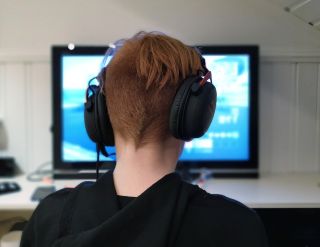Students struggle with digital disruptions affecting everything from their health to sleep to school performance. Schools can help families understand that there are solutions to these problems. Taking everything away from children when distraction becomes destructive is not a viable long-term solution as it can result in kids finding their own ways to steal moments to be connected, further exacerbating the problem.
Understanding the influence of a child’s online world can also provide a refreshing antidote. If you can't beat them, join them…?
This sounds contrary to conventional wisdom. Yet consider that there are digital mechanisms that students can leverage to redirect and reinforce their focus.
Students want to focus but the temptations interrupt their best intentions. Accessing these digital strategies affords teachers ways to show students alternatives that work.
Reversing Digital Disruption Strategy 1: Binaural Beats
Binaural beats allow students to wear headphones, and within minutes, access their high cognitive potential, focus, and engagement. This is a powerful reversal of the digital disruption that teachers and parents groan about, throwing their hands in the air in frustration.
How and why binaural beats work:
Optical illusions are so powerful, they can trick your mind in good and bad ways. Think of a virtual reality ride or VR headsets. These fool our senses so convincingly, we can feel as if the sensation is really happening, even when we know it is not. Binaural beats act in the same powerful way and can be positively constructed for children.
Binaural beats present an illusion caused by listening to two tones that send signals at slightly different frequencies, in each ear. The difference in frequencies generates a third perceived tone -- a rhythmic beat. Here is the cool, scientific part: neurons throughout the brain deliver messages at the same rate as the imaginary beat, causing physiological responses based on the beats effect. Creating a focused beat sets in motion a cognition that nourishes our senses. That is virtual reality at its best!
Binaural beats can offer different pulses for different effects, based on the kind of brain waves being channeled. A quick summary of those types and effects of each:
- Delta pattern: operate at a frequency that elicits a deeper stage of sleep
- Theta pattern: contribute to improved meditation, creativity, and sleep in the rapid eye movement (REM) phase of sleep
- Alpha pattern: encourage relaxation
- Beta pattern: help promote concentration and alertness
- Gamma pattern: promote wakefulness
A balance of theta and alpha pattern wave brain flow seems to provoke the best state of mind for students to be primed with a focused and motivated mindset, ideal for learning.
Considering that listening to binaural beats for several minutes can induce the sweet spot for learning, it is surprising that we do not use these more in classrooms as an effective tool to reverse the harm of digital distractions, and allow students to gain a sense of high cognitive learning, on the spot.
Reversing Digital Disruption Strategy 2: Blue Light Screen Protectors
A second challenge that can be remedied is the saturating effects of blue light caused by high cell phone and computer screen use. Overexposure to blue light alters circadian rhythm in ways that throw off a child’s natural resting state. This confuses the brain as blue light mimics the brightness of the sun, causing the brain to stop producing melatonin, a hormone that gives your body cues to sleep. This is a large part of why students are not sleeping well enough. Sleep is critical to focus, alertness and energy.
The use of blue light blockers has not been well documented yet. But there is evidence that reducing blue light exposure helps bring the body to a normal chronology, providing the rest necessary for young minds to be better primed for the next day.
By implementing these two remedies, we can help bolster student focus and energy. It is worth the time and effort to share, teach, and reinforce these as ways to remedy the disruptions caused by digital exposure.
Where do I start?
- A resource such as this one can help kids regain their focus quickly through binaural beats
- This resource offers what to know and to look for in blue light blocking screen protectors for phones and computers
Remember, we have solutions to digital disruption. Students (and adults) can prime their focus on demand, and can leverage blue light blocking technologies. Indulging in alpha-theta states and restoring rested minds translates to focused minds. Leveraging these two simple strategies will go a long way for our students.

